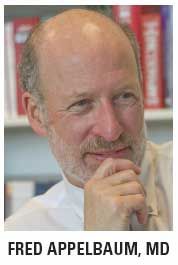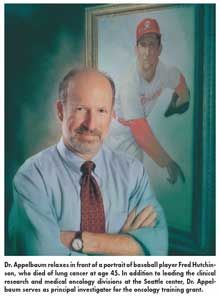A maverick blazes new trails for leukemia research
Growing up in Canton, Ohio, Fred Appelbaum, MD, dreamt of cowboys, cattle rustling, and a career in medicine- of sorts. “It wasn’t until I was an undergrad at Dartmouth College that I thought seriously about medicine. But I didn’t think about academic medicine or research. I thought I’d end up a small-town doc like in Gunsmoke,” explained Dr. Appelbaum, referring to the popular TV series from the 1950s.
ABSTRACT: Fred Appelbaum, MD, marshalls teaching, patient care, and trials.
Growing up in Canton, Ohio, Fred Appelbaum, MD, dreamt of cowboys, cattle rustling, and a career in medicine- of sorts. “It wasn’t until I was an undergrad at Dartmouth College that I thought seriously about medicine. But I didn’t think about academic medicine or research. I thought I’d end up a small-town doc like in Gunsmoke,” explained Dr. Appelbaum, referring to the popular TV series from the 1950s.

As a leader and pioneer in acute myeloid leukemia research, Dr. Appelbaum tread a vocational path more in line with that of Gunsmoke’s Marshall Matt Dillon than of Dr. Galen “Doc” Adams. He now serves as director of the clinical research division at Seattle’s Fred Hutchinson Cancer Research Center. He is also head of the division of medical oncology at the University of Washington and executive director of the Seattle Cancer Care Alliance.
Dr. Appelbaum sat down with Oncology News International to discuss his life in medicine and the decades of work that have helped transform leukemia into a highly treatable disease.
A stint in pediatric oncology
As a medical student at Tufts University School of Medicine in Boston in the early 1970s, Dr. Appelbaum was introduced to hematology via the journal Blood. “I read an article by E. Donnall Thomas, MD. It was the fi rst description of using bone marrow transplantation to try to treat leukemia. Within minutes of reading the article, I knew that’s what I wanted to do,”
Dr. Appelbaum said. Dr. Thomas won the 1990 Nobel Prize in Physiology or Medicine. Dr. Appelbaum received his medical degree from Tufts in 1972 and accepted an invitation to become a clinical associate at the National Institutes of Health (NIH).
“When I was accepted at NIH, I anticipated doing research in leukemia and bone marrow transplantation,” he related. But between his application and acceptance, some reorganization took place at the NIH. Dr. Appelbaum recalled receiving a call from John Ziegler, MD, who won the 1972 Albert Lasker Clinical Medical Research Award for his work in Burkitt’s tumor.
“Dr. Ziegler welcomed me to NIH. Then he told me that the leukemia branch I was interested in no longer existed. I was being assigned to pediatric oncology,” Dr. Appelbaum said. “I told Dr. Ziegler that I wasn’t a pediatrician and he said, ‘Don’t worry, Fred, neither am I.’”
It turned out to be a rewarding period during which Dr. Appelbaum worked on exciting animal model studies in bone marrow transplantation that served as the building blocks for treatment in humans.
Summons from a Nobel laureate

During his fourth year at NIH, Dr. Appelbaum received an unexpected call from Dr. Thomas himself. “Don asked if I was interested in joining the research group in Seattle. I was thrilled. Naturally, I accepted the offer, and I’ve been with the institution for the past 30 years,” he said.
As an assistant professor at the Hutchinson center, Dr. Appelbaum spent his fi rst two months as a fellow in the transplant service, taking care of patients and using the knowledge he gained in autologous transplantation at the NIH to set up some clinical trials at Hutchinson.
After two years on the wards, Dr. Appelbaum shifted to lab research. “At that time, I was interested in trying to improve the methods for conducting bone marrow transplantation,” he explained. “My major interest was using monoclonal antibodies to direct radioisotopes to the marrow and other sites of leukemia so we could do an effective transplant.”
In 1983, Dr. Appelbaum became a full member of the Hutchinson Center faculty and a professor of medicine in the division of oncology at the University of Washington.
Taking the lead

“In 1993, Don Thomas retired, and I took over as head of the general transplant program and division of clinical research at the Hutch,” Dr. Appelbaum explained. “I became a principal investigator in certain trials that helped refi ne transplant procedures. During that time, my own work centered on the biology and treatment of acute myeloid leukemia.”
Dr. Appelbaum currently serves as principal investigator at the Adult Leukemia Research Center at the Hutch. Studies that he has been involved with include Cancer and Leukemia Group B study 19801 for nelarabine in adults with relapsed or refractory T-lineage acute lymphoblastic leukemia or lymphoblastic lymphoma (Blood 109:5136-5142, 2007) and a phase III trial of fludarabine plus cyclophosphamide for patients with previously untreated chronic lymphocytic leukemia (U.S. Intergroup Trial E2997; J Clin Oncol 25:793- 798, 2007).

With the Southwest Oncology Group (SWOG), Dr. Appelbaum has worked on such groundbreaking trials as SWOG-9400, which investigated the impact of cytogenetics on the outcome of adult acute lymphoblastic leukemia (Blood 111:2563-2572, 2008). Another trial, SWOG 9500, was a phase II evaluation of an intensified induction therapy with standard daunomycin and cytarabine followed by high-dose cytarabine for adults with previously untreated acute myeloid leukemia (Am J Hematol 82:1056-1062, 2007).
A landmark negotiation that Dr. Appelbaum spearheaded placed hematology/oncology services at the university, Seattle Children’s Hospital, and the Hutch under one umbrella. “Before that, we had world-class hematologic research capabilities at the Hutch, but the new collective approach expanded our scope into becoming a major research center in all aspects of oncology,” he said.
These days, Dr. Appelbaum divides his time among direct patient care, Hutch administration, SWOG leukemia group chairing responsibilities, and teaching. “I really believe I have about the best job in the world. I’d actually do this for free,” he said. “It’s a joy to be able to help my patients, even when cure is no longer an option. When I’m doing patient care, the other things I need to take care of tend to get pushed back.”